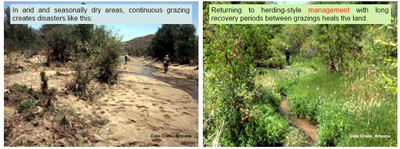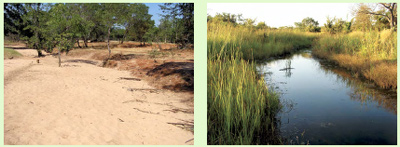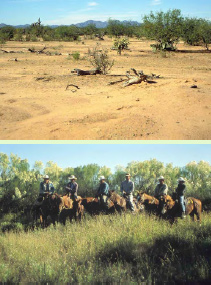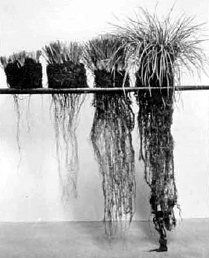Restoring soil carbon can reverse global warming, desertification and biodiversity loss
Restoring soil carbon can reverse global warming, desertification and biodiversity loss
mongabay.com
February 21, 2008
|
|
Restoring the ability of soil to store carbon by promoting native grasses and vegetation can help reverse global warming, desertification and biodiversity loss, says an Australian researcher.
Land use change — including deforestation, bush fires, and soil degradation — accounts for roughly 20 percent of global greenhouse gas emissions, but land management practices can be used to reduce emissions. While reforestation and avoided deforestation have garnered a lot of attention of late, restoration of other forms of vegetation can dramatically increase the capacity of degraded landscapes to store carbon.
Tony Lovell of Soil Carbon P/L in Australia estimates that by actively supporting regrowth of vegetation in damaged ecosystems, billions of tons of carbon dioxide can be sequestered from the atmosphere.
In February 2008, Lovell discussed the potential of soil carbon restoration.
Mongabay: What are the advantages of increasing the capacity of soil to store carbon?
Lovell:
 In arid and seasonally dry areas, continuous grazing creates disasters like that on the left. Returning to herding-style management with long recovery periods between grazings heals the land (right) |
We are not so much increasing the capacity of soil to store carbon as restoring its ability to store carbon. The result of conventional agricultural practices such as artificial fertilizing, ploughing, stubble burning, bare fallows, etc is to run down the organic matter in the soil, and it is this organic matter that is the source of stored soil carbon. The main advantages in direct global warming terms (sources/sinks) of restoring soil’s ability to store carbon are that it is immediate, massive and involves capturing excess CO2 from atmospheric circulation. There are additional huge benefits in terms of water retention, drought tolerance, biodiversity increase, cost decreases, etc as well.
The immediacy is a result of using the natural biological process of photosynthesis — as the grasses and other plants grow they absorb C02 each and every day.
The massive capacity is simple mathematics.
Determining how much carbon dioxide (CO2) can physically be consumed from the atmosphere?
 LEFT: This river in Zimbabwe used to flow year-round. Then overgrazing by wandering livestock bared much of the soil in the surrounding area. Today the river flows only as flash floods following heavy rains. Biodiversity loss is severe, livestock are starving, and most wildlife has disappeared. RIGHT: This nearby river had similar problems. It now has water year-round, and flows during most of the year. Drought is rare, biodiversity is increasing, and wildlife has reappeared in large numbers. Soil Carbon P/L notes that capturing just 1 mm more rain per year means: 1 liter more usable water per square meter; 10,000 liters more water per hectare; 1,000,000 liters more water per square kilometer; Less drought, because more water stays in the soil to recharge rivers, springs, and wells; and more forage, because plants can also use that water. |
As the planet has 7.8 billion tonnes of carbon dioxide in circulation for each 1 ppm of atmospheric CO2, and there are 5 billion hectares of inappropriately managed or unmanaged, desertifying savannahs on the Earth (which on empirical evidence we contend to be the case), the question that should sensibly be asked is:
How much carbon dioxide would be absorbed if policies were put in place (in Australia and elsewhere) that caused the focus of on-ground management to be
deliberately directed towards the widespread consumption of cyclical GHGs within the currently under-utilised savannah lands?
Consumption of CO2 per hectare
- One hectare is 10,000 sq. metres. If a hectare of soil 33.5 cm deep, with a bulk density of 1.4 tonnes per cubic metre is considered, there is a soil mass per hectare of about 4,700 tonnes.
- If appropriate management practices were adopted and these practices achieved and sustained a 1% increase in soil organic matter (SOM)6, then 47 tonnes of SOM per hectare will be added to organic matter stocks held below the soil surface
- This 47 tonnes of SOM will contain approximately 27 tonnes of Soil Carbon (ie 47 tonnes at 58% Carbon) per hectare
- In the absence of other inputs this Carbon may only be derived from the atmosphere via the natural function known as the photo-synthetic process. To place approximately 27 tonnes of Soil Carbon per hectare into the soil, approximately 100 tonnes of carbon dioxide must be consumed out of the atmosphere by photosynthesis
- A 1% change in soil organic matter across 5 billion hectares will sequester 500 billion tonnes of physical CO2
Converting global Soil Carbon capacity to ppm of atmospheric GHGs
- Every 1% increase in retained SOM within the topmost 33.5 cm of the soil must capture and hold approximately 100 tonnes per hectare of atmospheric carbon dioxide (the variability in the equation being due only to the soil bulk density). We submit that under determined, appropriate management, that this is readily achievable within a very few years
- For each 1% increase in SOM achieved on the 5 billion hectares there will be removed 64 ppm of carbon dioxide from atmospheric circulation
(500,000,000,000 tonnes CO2 / 7,800,000,000 tonnes per ppm = 64 ppm). - Soil Organic Matter is the plant material released into the soil during the natural phases of plant growth. It includes root material sloughed off below the soil surface and plant litter carried into the soil by microbes, insects and rainfall
- Soil Carbon is the elemental carbon contained within Soil Organic Matter (SOM).
- One tonne of CO2 contains 12/44 units of carbon (ie 0.27 tonnes of carbon per tonne of CO2.). Therefore 27 tonnes of carbon sequesters 27/0.27 = 100 tonnes CO2 (rounded). NB Carbon atomic weight 12, oxygen atomic weight 16 ie CO2 = 12+(16+16) = 44
The global opportunity and numbers
 TOP: This cattle ranch in Sonora, Mexico, is typical of hundreds of millions of hectares of grazing land in arid and seasonally dry areas worldwide. BOTTOM: This is the neighboring ranch, La Inmaculada. The ranch is in the same area; has the same rainfall, same soils, and same plant species. The pictures were taken on the same day and La Inmaculada actually has more cattle than the drier ranch. The only difference between the two is management |
It appears that the pre-industrial level of atmospheric carbon dioxide was 280ppm, and that globally we are now at 385ppm*, and heading towards 550ppm. To get from 550ppm back to 280ppm, 270ppm must be removed. Globally, a 4.2% increase in SOM would potentially reverse the expected situation. In any case, any form of determined management will substantially reduce the now crippling legacy loadings in the atmosphere.
Mongabay: How does one restore carbon to the Earth?
Lovell:
By actively mimicking nature and thereby allowing natural cycles to reinvigorate. Arid and semi-arid grazing lands co-evolved with massive herds of grazing animals that were kept bunched up by the presence of pack-hunting predators. When humans removed these predators and fenced in the animals we severely disrupted this natural behaviour leading directly to desertification and massive release of soil carbon into atmospheric circulation. The process that actually removes CO2 from atmospheric circulation is photosynthesis. A simple question for anyone — think of the biggest plant you have ever seen — it is probably a huge tree more than 50 metres tall, 10 metres around and weighing hundreds of tonnes. You can walk up to this tree and hit it — it is solid. Where did the material come from to make this tree? Far too many people answer — “from the ground the tree is growing in”. The truth is that over 50% of the solid “thumpable” bit of the tree came directly out of the atmosphere as CO2. While a tree is much more visible than grass, the result is the same.
The global opportunity and numbers

|
This simple picture says it all — if we allow the grasses to express themselves to the stage shown on the right they absorb CO2 from atmospheric circulation and turn it into plant material. We then manage our grazing animals to eat the grass down to the level somewhere between the middle 2 grass plants. At this point the reduced leaf mass is unable to support the large root mass, and so the plant sloughs off the now excess root material (carbon). The plant then commences to regrow but critically it regrows using carbon absorbed by photosynthesis, not the carbon it previously sloughed off. Repeat this process and you in essence “pump” CO2 out of the atmosphere and store it underground.
Mongabay: What does Soil Carbon Australia offer?
Lovell: Our main focus is on raising awareness of the important role soil carbon plays in mitigating global warming, and ideally on having it recognized as a tradeable item under any global emissions trading scheme. This will dramatically change the incentives that farmers respond to and thus bring about a massive positive change in agricultural practices.
Mongabay: Where are you working?
Lovell:
We are based in Australia, and have colleagues in the USA, New Zealand, Spain, England, South Africa and South America.
Mongabay: Have you looked at the potential to earn carbon credits for sequestration?
Lovell: Yes — it is widely recognized and accepted that soil carbon sequestration works — the only questions are ones of measurement, monitoring and verification (MMV). We as a society have dealt eith these MMV issues in regards to afforestation and deforestation so should be able to do so with regards to soil carbon.
Mongabay: Are you familiar with “terra preta” soils in the Amazon? If so, how does your process compare with this form of soil carbon?
Lovell: “terra preta” is probably the best example of just what we are talking about — a carbon rich, biologically active soil created as a result of appropriate human management. In the 5 billion hectares we want to bring attention to the results will not be as dramatic due to the lower rainfall and inherently poorer quality of the soils themselves, but the results will be significant and well worthwhile.
*This was erroneously listed as 455 ppm
Further information